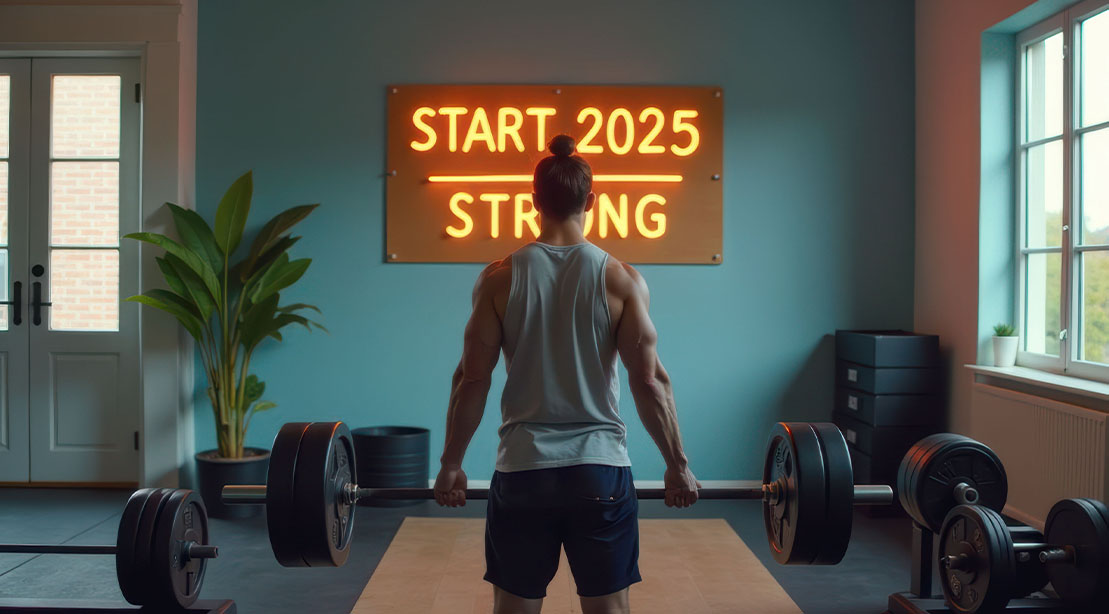New Year Muscle Building for Beginners

Train, Don’t Just ‘Work Out’
If you’re scratching your head at that one, you aren’t alone. Many people that go to the gym see these terms as interchangeable, but Feather feels that one shows a greater level of commitment, which can lead to greater gains.
“Working out is simply moving weight—often to complete a prescribed set and rep scheme or hit a certain load,” he said. “Training, on the other hand, involves purposeful execution aimed at optimizing stimulus for a specific adaptation, like muscle growth.”
Prioritizing Technique Over Load
The thought of lifting weight may be a motivating one, and the appeal of slinging huge dumbbells and loading a sleeve full of 45s, but Feather advised that the premise of training should be different. Mastering the way you lift instead of what you lift matters the most.
“Proper technique keeps the load on the target muscle throughout the movement,” he explained. “For example, during a squat, maintaining upright posture and hitting proper depth ensures the quads are doing most of the work instead of shifting tension to the lower back or hips. This is especially important for hypertrophy, as mechanical tension is the primary driver of muscle growth.”
Focus On The Lengthened Portion of Movements
Exercises that offer a greater range of motion and allow you to lengthen the muscle while maintaining tension are more challenging but worth the investment that comes with it. Feather shared a few examples that you should consider adding into your own program, if you don’t do them now.
“Movements like Romanian deadlifts, incline/lying curls, or deep squatting variations stretch the target muscle under tension, which can enhance growth,” he shared. This may be the opposite of what you learned when you first started training – that the contraction matters the most. Remember that as you progress, you need to keep an open mind and try new things to see new results.
Why You Want to Apply This Knowledge
The RP Strength Team conducted a “Scientific Training” series, which included small yet significant adjustments to how their clients trained. Feather said that the feedback they got from that series validated all these strategies to be beneficial.
“By focusing on better movement mechanics, proper range of motion, and load management, we’ve helped them achieve:
- Improved Pump: Enhanced blood flow and muscle activation from better execution.
- Targeted Muscle Feel: Greater activation of the intended muscle group rather than accessory muscles.
- Reduced Joint Pain: Decreasing unnecessary joint stress through better mechanics and appropriate load selection.”
Track More Progress and Achieve More Results
Aside from sharing their wisdom, RP offers ways to help you apply what you’ve learned and see the results through yourself. They have their own content pages, YouTube channel, and books that back up their advice with evidence. They also have an app that works like a coach and training log in one. You can use to track your own workouts and follow its suggestions to maximize your potential.
“RP provides an extensive collection of resources to help lifters add quality size, whether they are looking to deepen their academic understanding of hypertrophy or enhance their athletic performance.”
Conclusion
Feather and the RP Strength team have shared valuable insights into the world of training, emphasizing the importance of prioritizing technique, focusing on the lengthened portion of movements, and tracking progress. By applying these principles, you can take your training to the next level and achieve greater results. Remember to stay committed, stay patient, and stay open-minded, and you will be on your way to reaching your fitness goals.
Frequently Asked Questions
Q: What is the difference between working out and training?
A: Working out is simply moving weight, while training involves purposeful execution aimed at optimizing stimulus for a specific adaptation, like muscle growth.
Q: Why is proper technique important?
A: Proper technique keeps the load on the target muscle throughout the movement, which is especially important for hypertrophy, as mechanical tension is the primary driver of muscle growth.
Q: What are some exercises that offer a greater range of motion and allow me to lengthen the muscle while maintaining tension?
A: Exercises like Romanian deadlifts, incline/lying curls, or deep squatting variations are examples of movements that can enhance growth.

